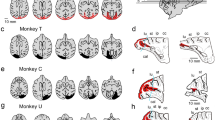Abstract
BLINDSIGHT, the visually evoked voluntary responses of patients with striate cortical destruction that are demonstrated despite a phenomenal blindness, has attracted attention from neuroscientists and philosophers interested in problems of perceptual consciousness and its neuronal basis1–3. It is assumed to be mediated by the numerous extra-geniculostriate cortical retinofugal pathways whose properties are studied primarily in monkeys4. Like patients with blindsight4–7, monkeys with lesions of the primary visual cortex can learn to detect, localize and distinguish between visual stimuli presented within their visual field defects4,8–11. Although the patients deny seeing the stimuli they can nevertheless respond to (by forced-choice guessing) in their phenomenally blind fields, it is not known whether the monkeys experience the same absence of phenomenal vision. To determine whether they too have blind-sight, or whether they actually see the stimuli in their field defects, monkeys who showed excellent detection in tasks where a visual stimulus was presented on every trial, albeit at different positions, were tested in a signal-detection task12 in which half the trials were blank trials, with no visual stimulus. They classified the visual stimuli presented in the field defect as blank trials, demonstrating, like patients, blindsight rather than degraded real vision.
This is a preview of subscription content, access via your institution
Access options
Subscribe to this journal
Receive 51 print issues and online access
$199.00 per year
only $3.90 per issue
Buy this article
- Purchase on Springer Link
- Instant access to full article PDF
Prices may be subject to local taxes which are calculated during checkout
Similar content being viewed by others
References
Crick, F. & Koch, C. Semin. Neurosci. 2, 263–275 (1990).
Nelkin, N. Phil. Sci. 60, 419–434 (1993).
Stoerig, P. & Brandt, S. Theor. Med. 14, 117–135 (1993).
Cowey, A. & Stoerig, P. Trends Neurosci. 14, 140–145 (1991).
Weiskrantz, L. Blindsight: A Case Study and Implications (Clarendon, Oxford, 1986).
Blythe, I. M., Kennard, C. & Ruddock, K. H. Brain 110, 887–905 (1987).
Weiskrantz, L. Proc. R. Soc. Lond. B239, 247–278 (1990).
Klüver, H. J. Psychol. 11, 23–45 (1941).
Cowey, A. & Weiskrantz, L. Q. J. exp. Psychol. 15, 91–115 (1963).
Mohler, C. W. & Wurtz, R. H. J. Neurophysiol. 40, 74–94 (1977).
Pasik, P. & Pasik, T. Contrs sens. Physiol. 7, 147–200 (1982).
Swets, J. A. & Pickett, R. M. Evaluation of Diagnostic Systems (Academic, New York, 1982).
Stoerig, P. & Cowey, A. Brain 114, 1489–1512 (1991).
Fendrich, R., Wessinger, C. M. & Gazzaniga, M. S. Science 258, 1489–1491 (1992).
Barbur, J. L., Ruddock, K. H. & Waterfield, V. A. Brain 103, 905–928 (1980).
Barbur, J. L., Watson, J. D. G., Frackowiak, R. S. J. & Zeki, S. Brain 116, 1293–1302 (1993).
Author information
Authors and Affiliations
Rights and permissions
About this article
Cite this article
Cowey, A., Stoerig, P. Blindsight in monkeys. Nature 373, 247–249 (1995). https://doi.org/10.1038/373247a0
Received:
Accepted:
Issue Date:
DOI: https://doi.org/10.1038/373247a0
This article is cited by
-
Utility of ganglion cells for the evaluation of anterior visual pathway pathology: a review
Acta Neurologica Belgica (2024)
-
HOTT and heavy: higher-order thought theory and the theory-heavy approach to animal consciousness
Synthese (2024)
-
Cortical neural dynamics unveil the rhythm of natural visual behavior in marmosets
Communications Biology (2022)
-
Phylogenetic Distribution and Trajectories of Visual Consciousness: Examining Feinberg and Mallatt’s Neurobiological Naturalism
Journal for General Philosophy of Science (2022)
-
The posterior parietal cortex contributes to visuomotor processing for saccades in blindsight macaques
Communications Biology (2021)
Comments
By submitting a comment you agree to abide by our Terms and Community Guidelines. If you find something abusive or that does not comply with our terms or guidelines please flag it as inappropriate.



